NOTÍCIA GENEALÓGICA

The exhibition « Notícia genealógica» (2023) at the chapel of Saint Benedict near the monastery of Alcobaça (Portugal) is a group of 14 paintings that I imagined and materialized for this specific place in order to form a corpus in situ. This chapel was founded in the eighth century at a time of political and religious upheaval in the region that was to become the kingdom of Portugal. Fearing the consequences of the arrival of the Muslim Moors on the coast, the Visigoth clergy built a hiding place (a cela) to preserve their statue of Saint Benedict of Nursia (ca. 480-547). Centuries later, the hiding place was converted into a chapel and incorporated into a quinta (manor), which in turn became the property of a noble family of Galician origin: the Andrade.
The 14 paintings represent portraits of the historical ancestors – from the 14th to the 19th century – of Maria Iva de Andrade Delgado, who went down in history as the wife of General Humberto Delgado (1906-1965), the Fearless General. The main opponent of dictator Salazar, Delgado was assassinated by the regime’s political police (PIDE) in February 1965. Himself of humble origins (his father was milkfed by a goat), he was fascinated by his wife’s genealogy and made local enquiries to complete data from the 19th century that was lacking. Having had the privilege of meeting his widow Maria Iva Delgado – who was almost a hundred years old at the time – I was all the more delighted to respond to her grandson’s challenge to bring the Andrade of the Quinta da Cela Velha back to life visually, in a way that is at once concrete, imaginary and poetic.
In Greta Gerwig’s film Barbie (2023), the heroine naively explains to a group of male workers that she has no vagina and that her friend Ken has no penis. This anecdote raises a forgotten but inescapable issue when you delve into the world of genealogy. Since these ‘hidden’ attributes are the conditio sine qua non for the continuation of the lineage – the Andrade of Cela Velha were a patrilineage between the fifteenth and nineteenth centuries – my gaze was guided by a desire to give women a prominent place. Their role as wives and mothers is highlighted like a star in a constellation, without reducing them to the role of gestation.

oil on cloth-lined board and wood with rope, 37×48 cm.
The Galician Jar (Gil and Isabel, 15th century).
Isabel holds in her hands a Calla lily flower, known in Portuguese as jarro (jar). In Christian iconography, this “flower of flowers” traditionally symbolises purity, innocence and possibly virginity, while for the Greeks this flower was attributed to the goddess Hera. According to a rather amusing legend, when Zeus brought his illegitimate son Hercules to drink her milk, Hera pushed him. Drops of her milk fell into the earth to create lillies, and into the sky to create the Milky Way. When Aphrodite the goddess of love and beauty saw these flowers for the first time, she became jealous of their beauty. She cursed them by adding a large yellow pistil to their core. In the Andrade coat of arms, imaginary snake-like creatures express a kind of emotional greed as if to devour this element of feminine beauty. Following today’s feminist perspective, the pistil evokes the clitoris. Isabel remains undisturbed by these aggressive heraldic elements, with a serenity of expression that reflects her historical role: it is she, not her husband, who passes on the Andrade family name, since it was considered more important. The patrilineage was literally inaugurated by a woman.
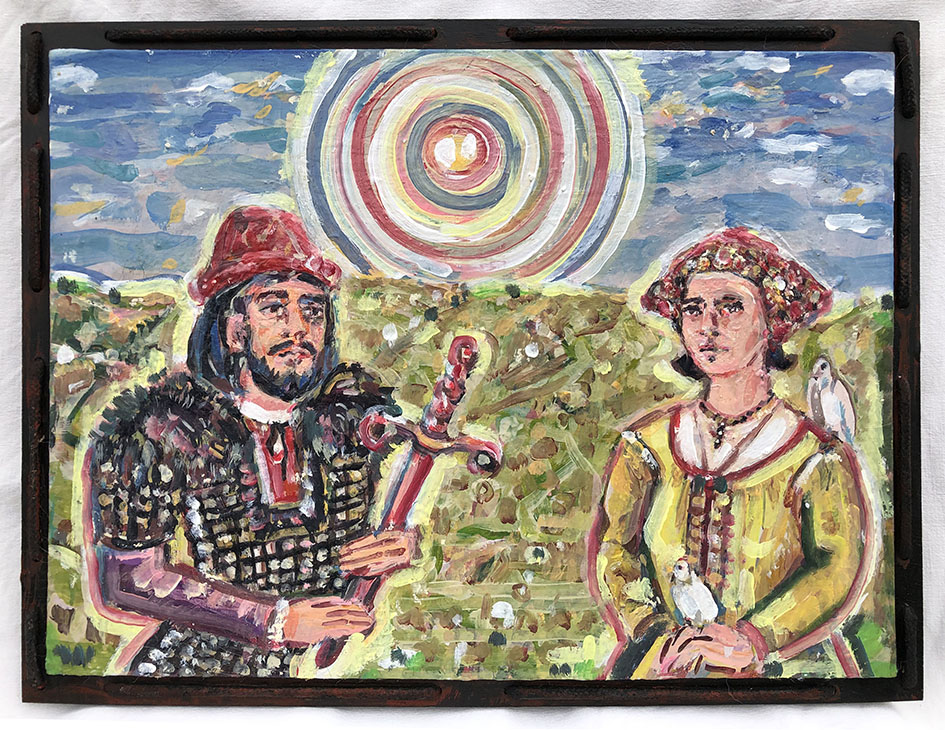
oil on cloth-lined board and wood with rope, 33×43 cm.
The Dove and the Sword (Francisco and Antónia, 15th century).
This couple lived in Lisbon, he being the lord of Bairro Alto – now a very touristy district of Lisbon. Francisco holds up a large sword, or rather points the pommels of the sword handle at his wife Antónia – daughter of the alcaide (mayor) of Leiria – like an apple that the biblical serpent offers to Eve. Doves alight on Antónia. This depiction is in line with Deborah Cameron’s book The Myth of Mars and Venus: Do Men and Women Really Speak Different Languages? (2008), which challenged the ‘essentialist’ precepts of John Gray in his classic and polemical work Men Are from Mars, Women Are from Venus (1992).

oil on cloth-lined board and wood with rope, 37×47 cm.
With Expectations (Tomé and Mécia, 15th century).
The oval shape of this painting accentuates the roundness of the belly of the woman expecting a baby. The couple’s hands are clasped together as if in prayer, and smoke billows between them with a small heart indicating the difficult relationship between expectations and the reality of love. Mécia wears a green dress, the colour of hope, and a headdress covers her head as patriarchal tradition requires; but Tomé, with his light hair free, joins his wife in this gesture of complicity.
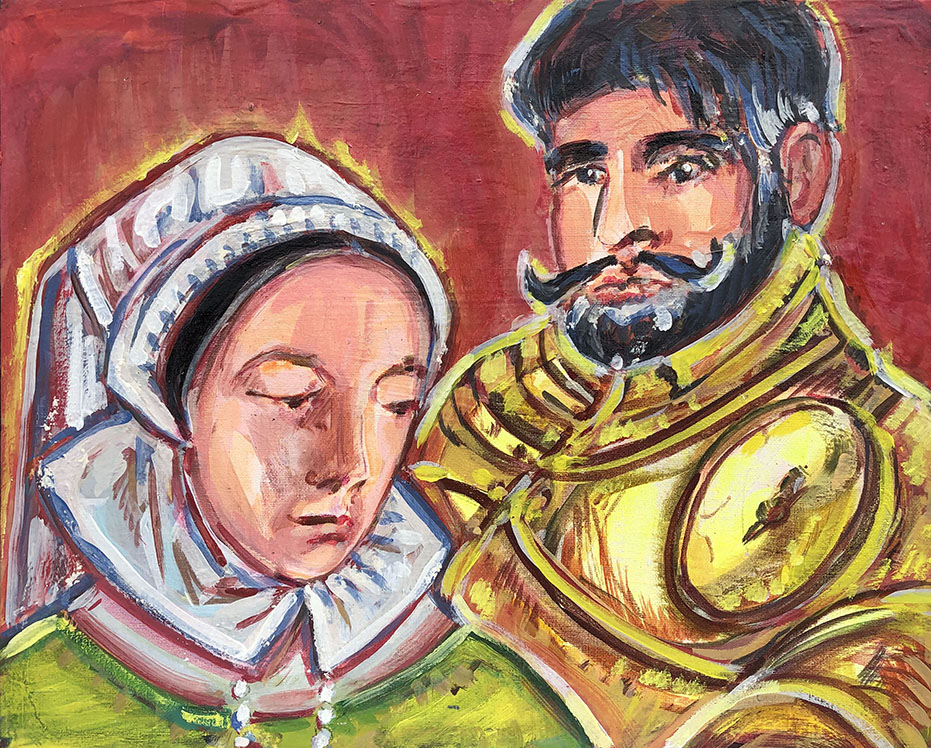
oil on cloth-lined board and wood with rope, 44x54cm
Armours (Mécia and Lopo, 15th and 16th centuries).
It seems that everything opposed them. Lopo, with his large moustache and shiny armour, guarded the home like a wolf guards his pack. Mécia, with her hair hidden by a white headdress and her eyes downcast, looks sad and submissive. But the real strength in the couple is Mécia. Sometimes short-tempered and stubborn, she likes to stand up to people. This hard worker manages the house with rigour and never gives in. Mécia had a magnetism, a radiance that touched everyone around her. According to an old superstition, wearing pearls to a wedding would ensure the bride’s tears. But Mécia was not superstitious and took her own pearls as a symbol of purity, but also of faith, divinity and wisdom. In fact, she heard from a sailor’s wife that the little white pearl trapped in the oyster’s shell is like a woman’s sexual intimacy.
The love of his wife is Lopo’s mainstay, but this quiet – not phlegmatic – man also draws strength from his virile looks. His Spanish-style moustache gives him the presence of a true macho, but his friends know that behind this iron appearance his profile can be influenced. He proclaims that friendship is sacred and that you should not touch your friends; but in the event of conflict he says yes to his wife with ease. A happy blend of sensitivity and raw masculinity, this intuitive man has a remarkable flair and a philosophical outlook on life. Sometimes he lingers on a desire to build a project that lies dormant in his contemplative soul. When this happens, it is Mécia who pushes him.

oil on cloth-lined board and wood with rope, 33×39 cm.
Flames (Mécia and Tomé, 16th century).
When Tomé was sent by King Dom Manuel I (1495-1521) as a diplomat to France and Germany, his young wife Mécia had to face alone the intrigues of the church and the nobility woven behind her husband’s back – intrigues that were of no interest to this young woman with a countryside spirit. But she could not afford to ignore the risks at the age of Inquisition – which for more than 250 years organised weekly show trials in Portugal’s largest cities. The portrait shows Mécia looking into the flames of a bonfire on which a victim is dying. How affected is she? Mécia Caiada de Gambôa is forced to be brave to the point of becoming a daredevil, as her social position is no warrant. Some twenty years later, at least one of her descendants would be implicated in an Inquisition trial.

oil on cloth-lined board and wood with rope, 43×33 cm.
The Jewel (Sebastião and Guiomar, 16th century).
This key painting in the family genealogy depicts the first Andrade to become owner of the Quinta da Cela Velha through his marriage to Dona Guiomar de Araújo. Sebastião reaches for the jewel in his wife’s necklace, a symbol of the real jewel, the quinta itself, evoked as a miniature with phosphorescent sparkles.
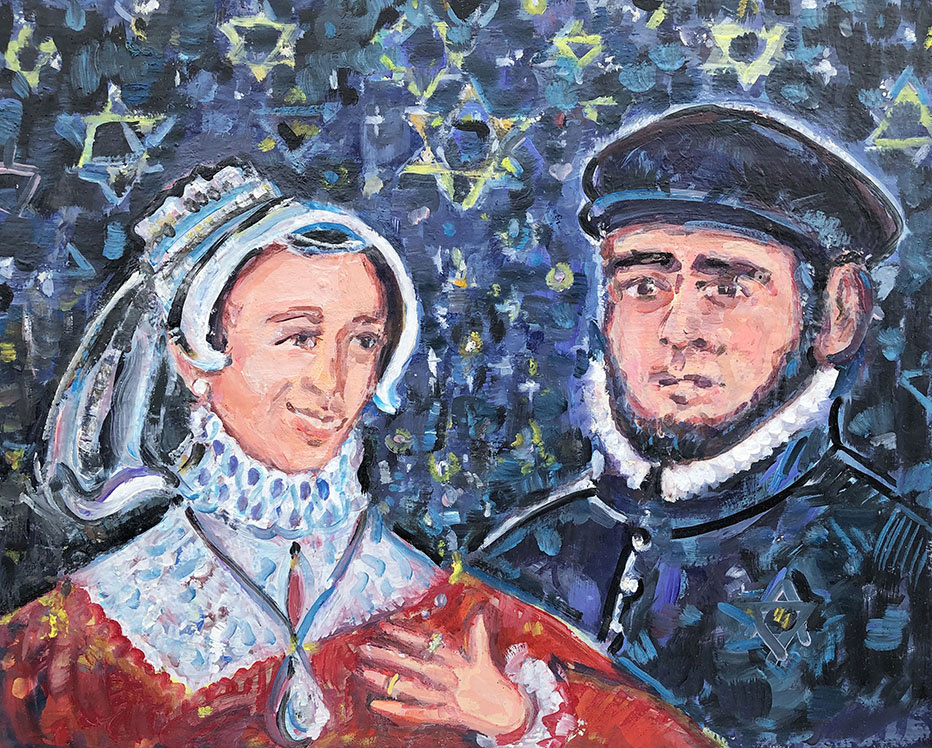
oil on cloth-lined board and wood with rope, 53×43 cm.
Stars (Isabel and Francisco, 16th and 17th centuries).
Isabel shows her wedding ring and wears a large family jewel in the shape of a teardrop. Handed down from one generation to the next, this jewel is depicted in various paintings. At first glance, she and her husband look very happy, as if in a wedding photo, whereas in their time a couple were not represented together in such a way. Painting has the power to transform reality and imagine the unspoken. Little by little, we notice that Isabel’s smile and white headdress contrast with Francisco’s closed face and black headdress. Behind them is the starry sky, except that stars of David are shining. Unlike the portraits created from photomontages of the facial features of the family’s descendants, Isabel’s was based on a photo of Mélita Gretzer, a Belgian Jewish refugee taken in by the Delgado family during the Second World War.

oil on cloth-lined board and wood with rope, 47×43 cm.
The Seal (António and Feliciana, 17th century).
At the bottom of the frame, almonds suspended by wires are reminiscent of a row of seals. This is because António’s name appears in an Inquisition process as suspect of “práticas judaizantes” (Judaic acts) in the chapel of Saint Benedict. Concealed beneath its shell, however, the almond is “the hidden truth”: it evokes mystery, the appearances that need to be overcome in order to reach the essential. Behind António, on a red background, we can read the first Hebrew letter, Aleph, which is both the beginning and the end – the end being the remembrance or the return to unity. The so-called Judaic acts of this fidalgo remain a mystery that not even the Inquisition was able to solve.
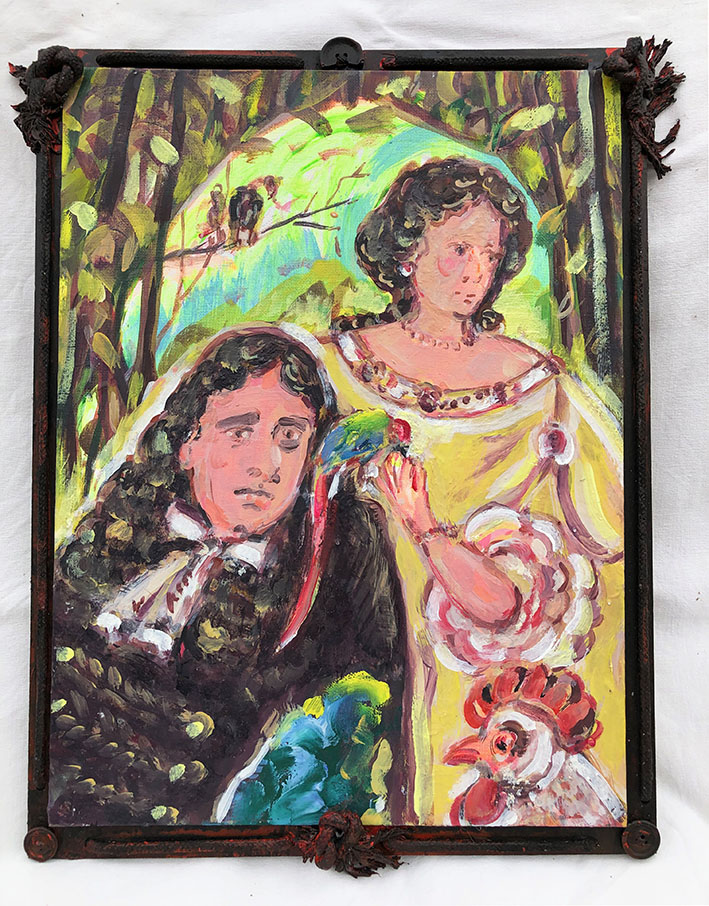
Parrot with Chicken (Francisco and Joana), 2023,
oil on cloth-lined board and wood with rope, 33×43 cm.
Parrot with Chicken (Francisco and Joana, 18th century)
Resting on Francisco’s shoulder, a parrot from Brazil testifies to the wealth and exoticism of the Portuguese empire, in dialogue with the pomp and circumstance of the man’s wig and Dona Joana’s new French dress embroidered with jewels. Their cosmopolitan worldliness is counterbalanced by the disconcerting presence of a hen in the foreground, which in turn bears witness to an eminently rural context. In particular, it stands for the folk references – and preferences – that the masters of the quinta shared with the peasantry. The parrot, it is said, also liked to fly away to mingle with the farm’s hens.

The Geese (Maria, Luís, António and Rosa Maria, 18th century)
Two women and two men of unequal status are brought together to discuss the affairs of the quinta, a subject whose epicentre is the document held in the hand of Dona Rosa Maria. She is the wife of António, the master of the house. Raising palmipeds – that is, geese, ducks and swans – is the order of the day. The adaptation of an old recipe for arroz de pato (rice with duck) – Antonio’s favourite dish – occasionally interferes with the discussion. Some take a pragmatic approach to the subject, holding a goose by the neck in a slightly ambiguous gesture, while trying to get everything down on paper. António’s younger brother Luis, on the other hand, seems to have a non-materialistic inspiration: his gaze wanders from the domestic scene to the height of the ceiling, where candles lit in a chandelier cast an almost mystical glow. The elegance of Dona Rosa Maria contrasts with the simple clothes of Maria, a commoner with whom Luís is in love. They were secretly engaged, but the family overcame the shock when he finally announced their mariage.

oil on cloth-lined board and wood with rope, 48×38 cm.
The Rose and the Litter (Ana Bárbara and Francisco, 18th century)
She dreamt of poetry and the scent of roses, and sometimes claimed that country life was not for her. But this was not true. Her spiritual life incorporated the farm with its hills and woods, its cultivated fields and animals. She loved to contemplate the oxen that crossed the farm and queued up to drink from its fountain; or the goats that frolicked under the shade of the olive trees. As for the pigs, they chose to roam around the chapel. They were allowed to do so freely because Dona Ana Bárbara had persuaded her husband on the pretext that the Queen of France lived surrounded by farm animals. If pigs took the place of Marie Antoinette’s sheep, it was also because they played a vital role in Portugal, and had done so for centuries: they were proof of a Catholic diet and warded off the potentially malevolent gaze of neighbours, who could at any moment slip in an accusation of Judaic inclinations. Under his wife’s poetic gaze, Francisco told his son António Carlos that he wanted to be buried in the chapel.
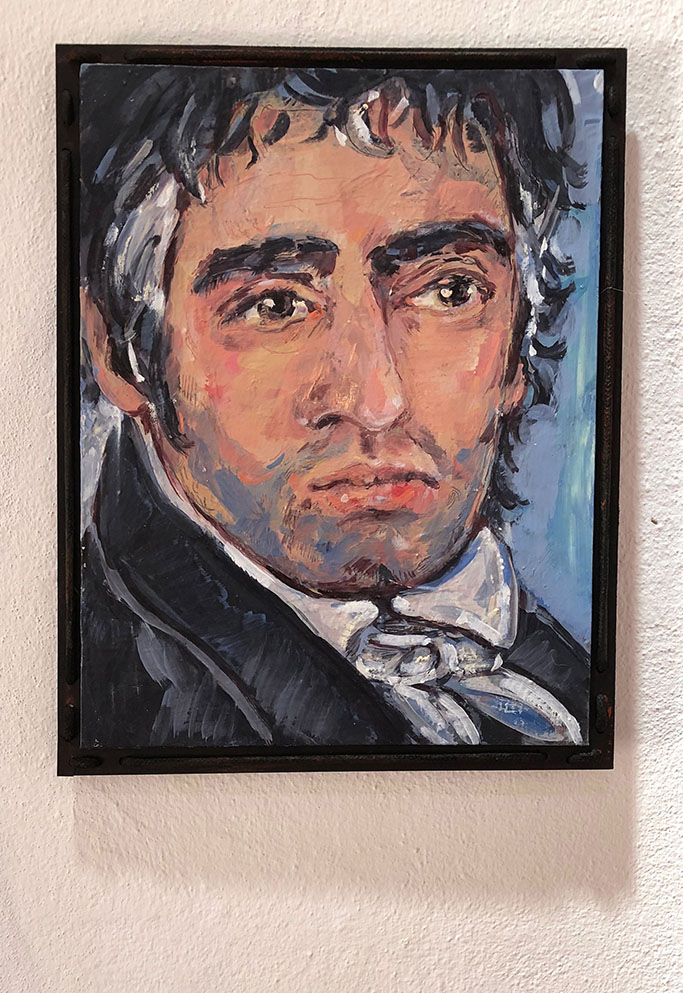
Expanded Horizons (António Carlos, 19th century).
It was at the time of his father’s death in 1804 that António Carlos asked the monks of Alcobaça to produce his family tree. This key figure is portrayed here as a romantic – like his contemporary Lord Byron, who lived in Portugal during the Napoleonic invasions and whose long poem Childe Harold’s Pilgrimage (1812-1818) made Sintra’s “glorious Eden” famous in England and elsewhere. A widowed father of five, António Carlos suffered from loneliness and the rusticity of his interlocutors, who admired him without him noticing. He did not go off on distant pilgrimages in search of inspiration; his only manuscript (1828) concerns local history. Caught between two ages, he never saw the train arrive in the village.

oil on cloth-lined board and wood with rope, 53×43 cm
Webs (Carlota, Máxima, Eduarda and Ana, 19th century).
The four women must be silent when this imaginary photograph was taken. The picture depicts the four daughters of António Carlos de Andrade e Gambôa – his son Carlos, the youngest, is absent. The only surviving photos (and there are quite a few of them) are of Eduarda, the eldest sister and true senhora da quinta since her father’s death. She married the engineer responsible for building the railway just down the hill. Behind the silence between the women there is the noise that the house spiders make as they spin their webs. The hands resting on her belly indicate that young Ana is pregnant, but unpronounceable rumours suggest that this condition belonged to her sister Carlota, a nun at the convent in Leiria. The noise of the webs woven between the sisters is as silent or as noisy as that of spider webs.
Waiting for the return of her husband King Ulisse’s mother, Penelope in The Iliad wove a web every day and unravelled it at night. But the four sisters Carlota, Máxima, Eduarda and Ana are not Penelope, and Cela velha is not Ithaca. The four sisters are waiting for something, and time is passing by. It is the time of generations, and of the future of the ancestors in each of us, occasional spectators.
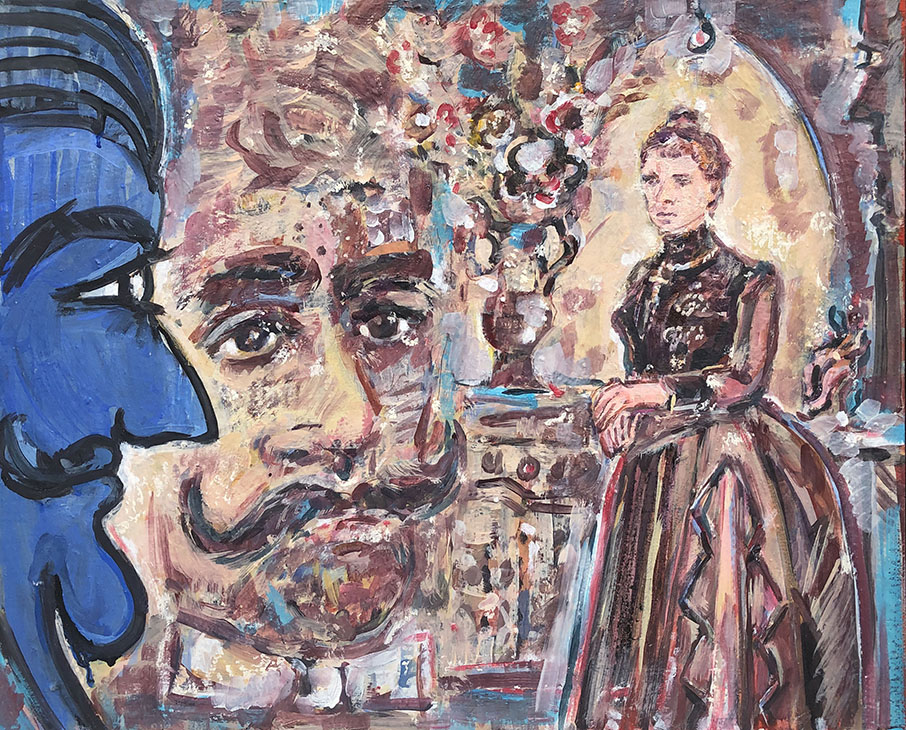
oil on cloth-lined board and wood with rope, 53×43 cm.
Infinities (José Eduardo and Maria Elisa, 19th and 20th centuries).
When the young José Eduardo was playing with gunpowder on the railway tracks in the village, he had no idea of the gravity of the situation. A violent explosion threw him into the air and disfigured his face for the rest of his life. On hearing this tragic news, his cousin Maria Elisa – who wanted to be a nun like her aunt – decided at that moment to leave the convent and marry him out of self-sacrifice. She would devote her love not to Jesus but to the unfortunate José Eduardo, whom no other woman would want as a husband. This painting superimposes a portrait of her and two portraits of him. One is of the handsome José Eduardo before the accident, and the other is based on a self-caricature drawn by himself as a premonition of the disfigured ‘monster’ he was to become. The granddaughter of this unhappy couple, Maria Iva Delgado, still knew them as a child and remembered the ghostly figure of her grandfather José Eduardo, his face hidden behind large dark glasses.
